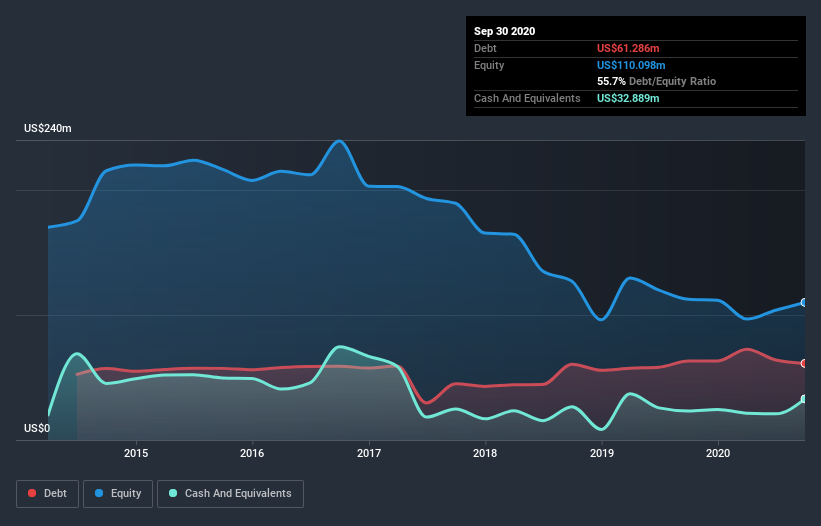
Some say volatility, rather than debt, is the best way to think about risk as an investor, but Warren Buffett famously said that 'Volatility is far from synonymous with risk.' So it seems the smart money knows that debt - which is usually involved in bankruptcies - is a very important factor, when you assess how risky a company is. Importantly, Mandalay Resources Corporation (TSE:MND) does carry debt. But should shareholders be worried about its use of debt?
Why Does Debt Bring Risk?
Debt and other liabilities become risky for a business when it cannot easily fulfill those obligations, either with free cash flow or by raising capital at an attractive price. Part and parcel of capitalism is the process of 'creative destruction' where failed businesses are mercilessly liquidated by their bankers. However, a more usual (but still expensive) situation is where a company must dilute shareholders at a cheap share price simply to get debt under control. Of course, the upside of debt is that it often represents cheap capital, especially when it replaces dilution in a company with the ability to reinvest at high rates of return. The first step when considering a company's debt levels is to consider its cash and debt together.
Check out our latest analysis for Mandalay Resources
What Is Mandalay Resources's Net Debt?
The chart below, which you can click on for greater detail, shows that Mandalay Resources had US$61.3m in debt in September 2020; about the same as the year before. However, because it has a cash reserve of US$32.9m, its net debt is less, at about US$28.4m.

How Strong Is Mandalay Resources' Balance Sheet?
We can see from the most recent balance sheet that Mandalay Resources had liabilities of US$74.5m falling due within a year, and liabilities of US$98.8m due beyond that. On the other hand, it had cash of US$32.9m and US$18.3m worth of receivables due within a year. So its liabilities total US$122.1m more than the combination of its cash and short-term receivables.
This deficit is considerable relative to its market capitalization of US$144.8m, so it does suggest shareholders should keep an eye on Mandalay Resources' use of debt. Should its lenders demand that it shore up the balance sheet, shareholders would likely face severe dilution.
In order to size up a company's debt relative to its earnings, we calculate its net debt divided by its earnings before interest, tax, depreciation, and amortization (EBITDA) and its earnings before interest and tax (EBIT) divided by its interest expense (its interest cover). This way, we consider both the absolute quantum of the debt, as well as the interest rates paid on it.
While Mandalay Resources's low debt to EBITDA ratio of 0.42 suggests only modest use of debt, the fact that EBIT only covered the interest expense by 6.2 times last year does give us pause. So we'd recommend keeping a close eye on the impact financing costs are having on the business. Although Mandalay Resources made a loss at the EBIT level, last year, it was also good to see that it generated US$31m in EBIT over the last twelve months. There's no doubt that we learn most about debt from the balance sheet. But it is future earnings, more than anything, that will determine Mandalay Resources's ability to maintain a healthy balance sheet going forward. So if you want to see what the professionals think, you might find this free report on analyst profit forecasts to be interesting.
Finally, a company can only pay off debt with cold hard cash, not accounting profits. So it is important to check how much of its earnings before interest and tax (EBIT) converts to actual free cash flow. During the last year, Mandalay Resources produced sturdy free cash flow equating to 52% of its EBIT, about what we'd expect. This cold hard cash means it can reduce its debt when it wants to.
Our View
Neither Mandalay Resources's ability to handle its total liabilities nor its EBIT growth rate gave us confidence in its ability to take on more debt. But its net debt to EBITDA tells a very different story, and suggests some resilience. Looking at all the angles mentioned above, it does seem to us that Mandalay Resources is a somewhat risky investment as a result of its debt. That's not necessarily a bad thing, since leverage can boost returns on equity, but it is something to be aware of. The balance sheet is clearly the area to focus on when you are analysing debt. But ultimately, every company can contain risks that exist outside of the balance sheet. We've identified 1 warning sign with Mandalay Resources , and understanding them should be part of your investment process.
At the end of the day, it's often better to focus on companies that are free from net debt. You can access our special list of such companies (all with a track record of profit growth). It's free.
If you decide to trade Mandalay Resources, use the lowest-cost* platform that is rated #1 Overall by Barron’s, Interactive Brokers. Trade stocks, options, futures, forex, bonds and funds on 135 markets, all from a single integrated account. Promoted
New: Manage All Your Stock Portfolios in One Place
We've created the ultimate portfolio companion for stock investors, and it's free.
• Connect an unlimited number of Portfolios and see your total in one currency
• Be alerted to new Warning Signs or Risks via email or mobile
• Track the Fair Value of your stocks
This article by Simply Wall St is general in nature. It does not constitute a recommendation to buy or sell any stock, and does not take account of your objectives, or your financial situation. We aim to bring you long-term focused analysis driven by fundamental data. Note that our analysis may not factor in the latest price-sensitive company announcements or qualitative material. Simply Wall St has no position in any stocks mentioned.
*Interactive Brokers Rated Lowest Cost Broker by StockBrokers.com Annual Online Review 2020
Have feedback on this article? Concerned about the content? Get in touch with us directly. Alternatively, email editorial-team (at) simplywallst.com.
About TSX:MND
Mandalay Resources
Engages in the acquisition, exploration, extraction, processing, and reclamation of mineral properties in Australia, Sweden, Chile, and Canada.
Outstanding track record with flawless balance sheet.
Market Insights
Community Narratives



